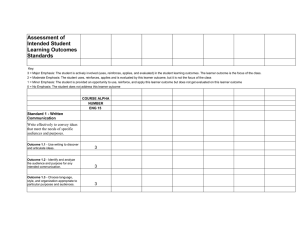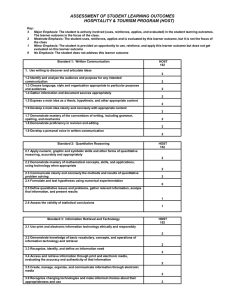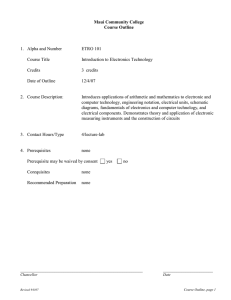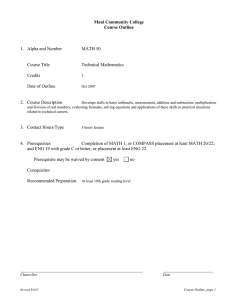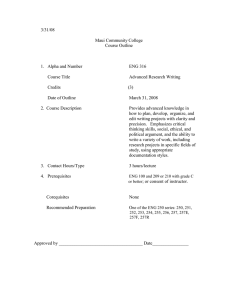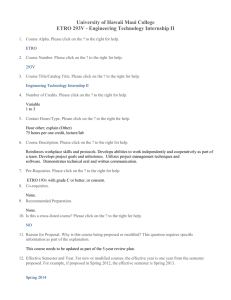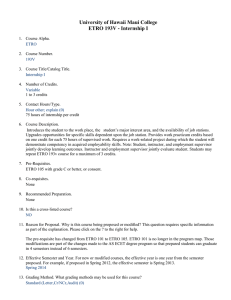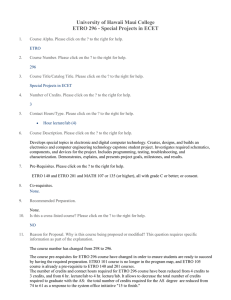2010.63 - Electronics (ETRO) 219: Calculus for Engineering Technology, Grid
advertisement
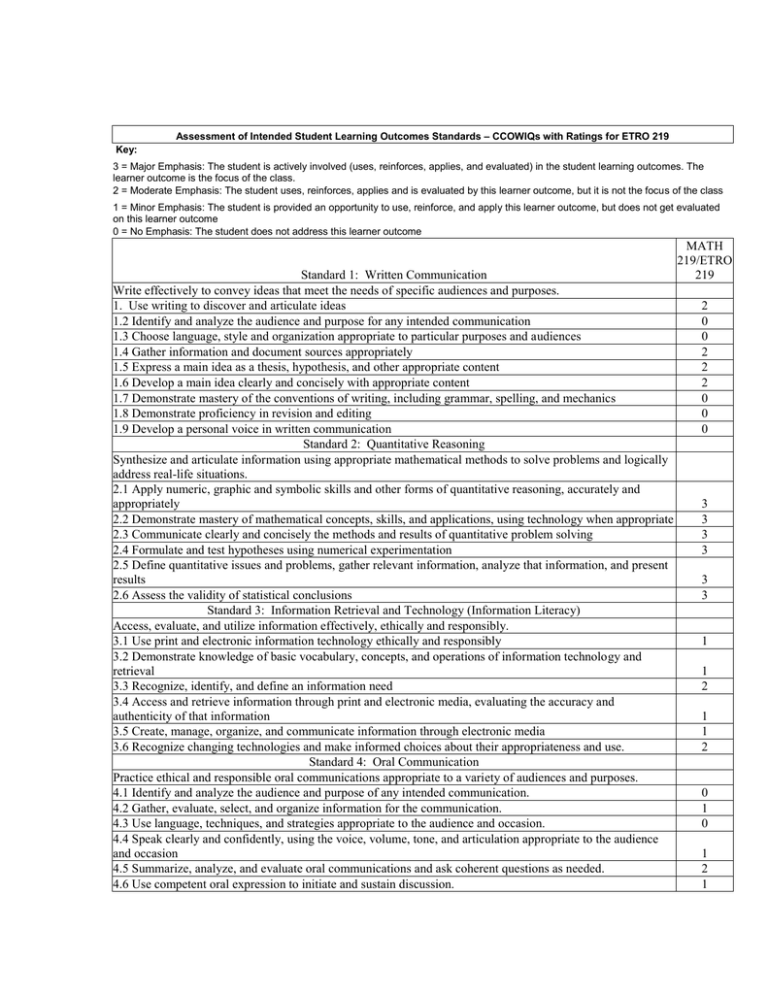
Assessment of Intended Student Learning Outcomes Standards – CCOWIQs with Ratings for ETRO 219 Key: 3 = Major Emphasis: The student is actively involved (uses, reinforces, applies, and evaluated) in the student learning outcomes. The learner outcome is the focus of the class. 2 = Moderate Emphasis: The student uses, reinforces, applies and is evaluated by this learner outcome, but it is not the focus of the class 1 = Minor Emphasis: The student is provided an opportunity to use, reinforce, and apply this learner outcome, but does not get evaluated on this learner outcome 0 = No Emphasis: The student does not address this learner outcome Standard 1: Written Communication Write effectively to convey ideas that meet the needs of specific audiences and purposes. 1. Use writing to discover and articulate ideas 1.2 Identify and analyze the audience and purpose for any intended communication 1.3 Choose language, style and organization appropriate to particular purposes and audiences 1.4 Gather information and document sources appropriately 1.5 Express a main idea as a thesis, hypothesis, and other appropriate content 1.6 Develop a main idea clearly and concisely with appropriate content 1.7 Demonstrate mastery of the conventions of writing, including grammar, spelling, and mechanics 1.8 Demonstrate proficiency in revision and editing 1.9 Develop a personal voice in written communication Standard 2: Quantitative Reasoning Synthesize and articulate information using appropriate mathematical methods to solve problems and logically address real-life situations. 2.1 Apply numeric, graphic and symbolic skills and other forms of quantitative reasoning, accurately and appropriately 2.2 Demonstrate mastery of mathematical concepts, skills, and applications, using technology when appropriate 2.3 Communicate clearly and concisely the methods and results of quantitative problem solving 2.4 Formulate and test hypotheses using numerical experimentation 2.5 Define quantitative issues and problems, gather relevant information, analyze that information, and present results 2.6 Assess the validity of statistical conclusions Standard 3: Information Retrieval and Technology (Information Literacy) Access, evaluate, and utilize information effectively, ethically and responsibly. 3.1 Use print and electronic information technology ethically and responsibly 3.2 Demonstrate knowledge of basic vocabulary, concepts, and operations of information technology and retrieval 3.3 Recognize, identify, and define an information need 3.4 Access and retrieve information through print and electronic media, evaluating the accuracy and authenticity of that information 3.5 Create, manage, organize, and communicate information through electronic media 3.6 Recognize changing technologies and make informed choices about their appropriateness and use. Standard 4: Oral Communication Practice ethical and responsible oral communications appropriate to a variety of audiences and purposes. 4.1 Identify and analyze the audience and purpose of any intended communication. 4.2 Gather, evaluate, select, and organize information for the communication. 4.3 Use language, techniques, and strategies appropriate to the audience and occasion. 4.4 Speak clearly and confidently, using the voice, volume, tone, and articulation appropriate to the audience and occasion 4.5 Summarize, analyze, and evaluate oral communications and ask coherent questions as needed. 4.6 Use competent oral expression to initiate and sustain discussion. MATH 219/ETRO 219 2 0 0 2 2 2 0 0 0 3 3 3 3 3 3 1 1 2 1 1 2 0 1 0 1 2 1 Standard 5: Critical Thinking Apply critical reasoning skills to effectively address the challenges and solve problems. 5.1 Identify and state problems, issues, arguments, and questions contained in a body of information. 5.2 Identify and analyze assumptions and underlying points of view relating to an issue or problem. 5.3 Formulate research questions that require descriptive and explanatory analyses. 5.4 Recognize and understand multiple modes of inquiry, including investigative methods based on observation and analysis. 5.5 Evaluate a problem, distinguishing between relevant and irrelevant facts, opinions, assumptions, issues, values, and biases through the use of appropriate evidence. 5.6 Apply problem-solving techniques and skills, including the rules of logic and logical sequence. 5.7 Synthesize inform from various sources, drawing appropriate conclusions. 5.8 Communicate clearly and concisely the methods and results of logical reasoning. 5.9 Reflect upon and evaluate their thought processes, value system, and world views in comparison to those of others. Standard 6: Creativity Able to express originality through a variety of forms. 6.1 Generates responses to problems and challenges through intuition and non-linear thinking. 6.2 Explores diverse approaches to solving a problem or addressing a challenge. 6.3 Sustains engagement in activities without a preconceived purpose. 6.4 Demonstrates the ability to trust and follow one’s instincts in the absence of external direction. 6.5 Applies creative principles to discover and express new ideas. 6.6 Builds upon or adapts the ideas of others to create novel expressions or new solutions. 3 3 2 2 3 3 2 1 2 1 3 0 1 1 1
